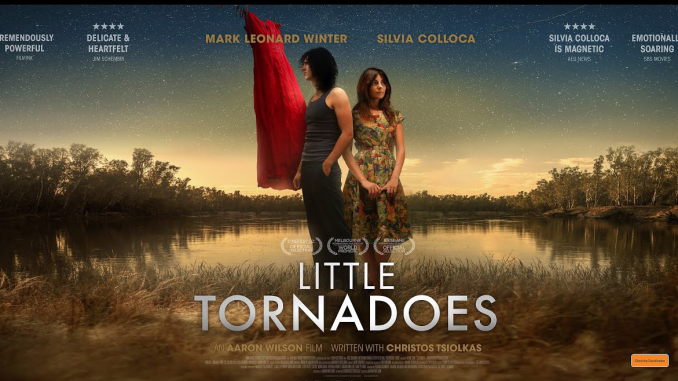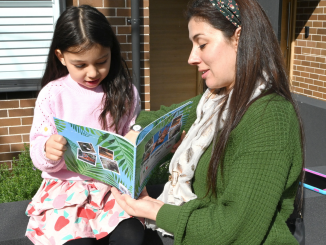
Little Tornadoes opened at Cremorne’s Hayden Orpheum Picture Palace in front of an audience of celebrity A-Listers, industry royalty and an appreciative gathering of local viewers. The screening, which included an introduction and Question and Answer panel featuring members of the cast and crew, played in front of a supportive house, including movie stars Simon Baker from ‘The Mentalist’ and Richard Roxburgh from ‘Baz Luhrmann’s Moulin Rouge”.
The film, which was shot in 2009, stars Mark Leonard Winter and ‘How to Cook Like an Italian’ host Silvia Colloca, as Italian migrant, Maria. This master class in cinematography provides the backdrop for an exploration of Australian stoicism and the changing cultural landscape. When asked why the film took so long to complete, Director Aaron Wilson said that “The film took as long as it needed to take” citing the significant additions and alterations made during a protracted and enriching post production.
The story follows Leo (Winter), a father of two, who finds himself suddenly abandoned by his wife and unable to cope with change. Sicilian work colleague Tony (Fabio Motta) offers the domestic assistance of his sister Maria (Colloca) who is looking for work. Both Fabio and Maria are catalysts for change in the lives of every person they touch. Maria and Fabio act as metaphors for Australia’s coming of age through immigration. Colloca is instantly charming, charismatic and engaging, and sets the celluloid alight in a scintillating performance.
Filmed in Wilson’s home town of Tocumwal, located near the Victorian, New South Wales, border, the film opens with the vast emptiness and remoteness of 1971 Australia. The only greater isolation we feel is in the hearts and the interpersonal relationships of the people that live there. “I was told I was coming to a new world when I first arrived here … even the birds sang a different song” says Maria who narrates the film in Italian, Sicilian and English. Immediately, the film juxtaposes the arresting discord between the loving, warm, nurturing Italians and the distant, uncaring, and often violent Australians. “The men don’t talk here”, states Maria in her narration. We see Leo making vegemite sandwiches and failing to be able to cook for his children. In later scenes we see Maria encouraging the children to have a relationship with food and bond over the Italian ritual of making pasta. In a haunting and arresting narration that brings goose pimples to the skin, we hear Maria say “Il cimitero australiano mi ha scioccato. Tutte quelle erbacce e tutta quella dimenticanza” (Australian cemetery’s shocked me. All those weeds and all that forgetfullness). The dirt and the spiderwebs on the gravestones are a harrowing illustration of the total disregard that these people have for one another. It’s Maria who wipes the gravestone clean, in the ultimate mark of respect, and wonders who is cleaning her widowed husband’s gravestone back in her homeland. In another of the film’s stark contrasts, she names the many who would share the responsibility.
On the evening of the first Sydney screening, I asked director Aaron Wilson “Are your bags packed”? He reflected on the question, “Because you are heading to Hollywood”. The same can be said for Colloca whose star far outshone the role and stays with you long after the curtains are drawn.
While Mark Leonard Winter perfectly embodies the role of the withdrawn but endearing protagonist, it is father Jim, played by Robert Mackenzie who embodies and accentuates the vast emptiness of the land that he propagates.
The film’s powerful production team was assembled by ‘Canopy’ Film Director Aaron Wilson. Collaborators include, Australia’s greatest Euro-centric wordsmith, Christos Tsiolkas (The Slap, Dead Europe),Oscar and Bafta Winning Music Editor Robert Mackenzie (Hacksaw Ridge, Deadline Gallipoli). Actress Silvia Colloca, speaking exclusively to Allora, was charged with translating much of the Italian for the film. “I had to take Christos’ words and translate them which was not easy. I am from Milan in the north and Maria is from Sicily way down in the south and I had to learn Sicilian. I got help from Fabio’s mother to translate some of Christos’ words into Sicilian”.
In the tradition of art imitating life, Colloca insisted that she cook the food appearing in the film, joking that “it was a low budget”. This provided an authenticity to the food which would be pivotal to the film’s plot and themes.
Another plot device which was central to the film was the use of motor cars. The masculine rumbling V8s used were sturdy, old, reliable beasts that overtly characterized the men that drove them. In a study of identity and the character’s personal journey’s, it was the motor car that brought the characters together, and like Colloca’s food, had the potential to close the gap (geographically and metaphorically) between frayed and estranged relationships. In one scene, the car radio blasted a news story about Alan Moffat and Peter Brock preparing to race at the Hardie Ferodo 500 in Bathurst. The iconic motor race is and was a tribal war played out in rural Australia and its protagonists at the time were the ‘unwanted’ immigrant, Canadian Moffat, competing against local hero, larrikin Peter Brock.
When asked about her own immigration experience, Silvia indicated that “I feel so privileged to have migrated when I did. These people who came on these ships long ago with nothing but a bag and seeds so that they had something to hang on to and something that they could plant when they arrived” experienced a very different Australia to the country that Colloca arrived in, in 2009.
Ultimately the film is a brutally honest depiction of the vast emptiness and harshness of the land and its people and how migrants, though unwanted, fill the vast void in Australia’s stoic heart. The film ends with the words, ‘Questa e’ la vita, questa e’ felicità, Un’ ora per abbracciarsi, e poi morire’. ‘Tis is life, and this is joy, An hour of embracing, and then to die’.




Be the first to comment